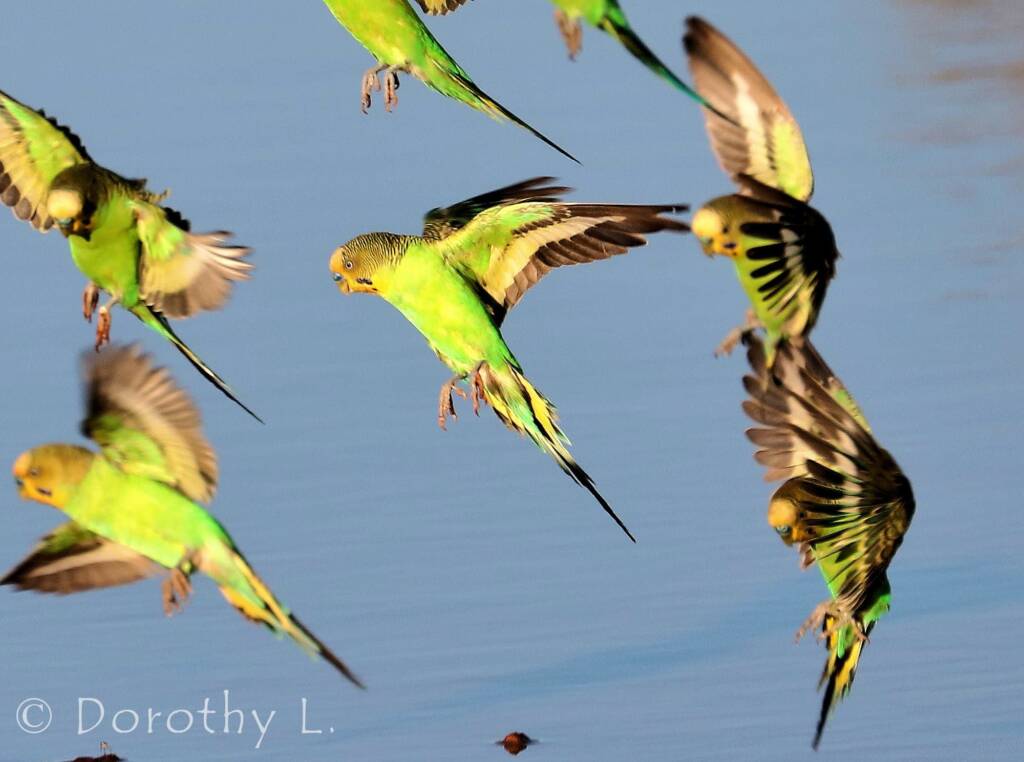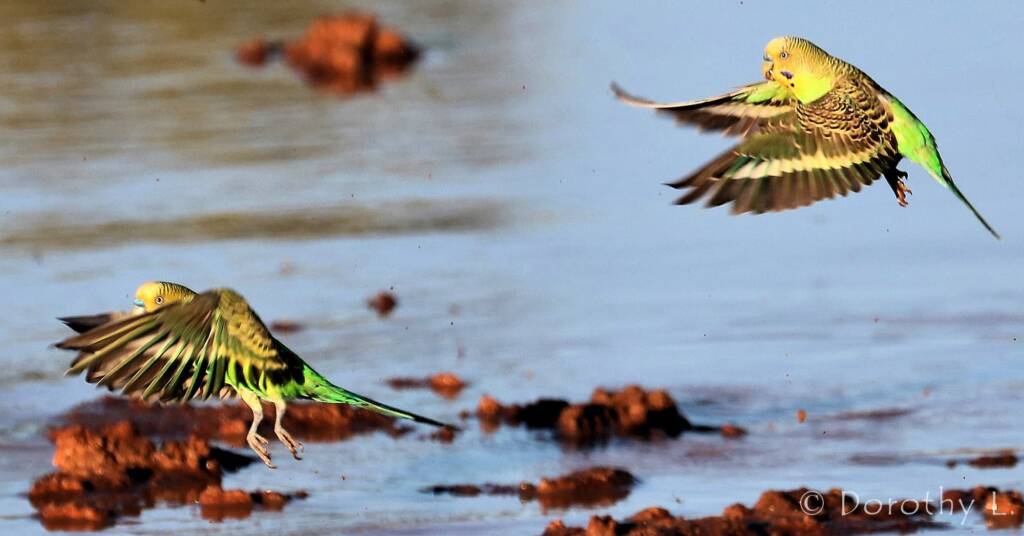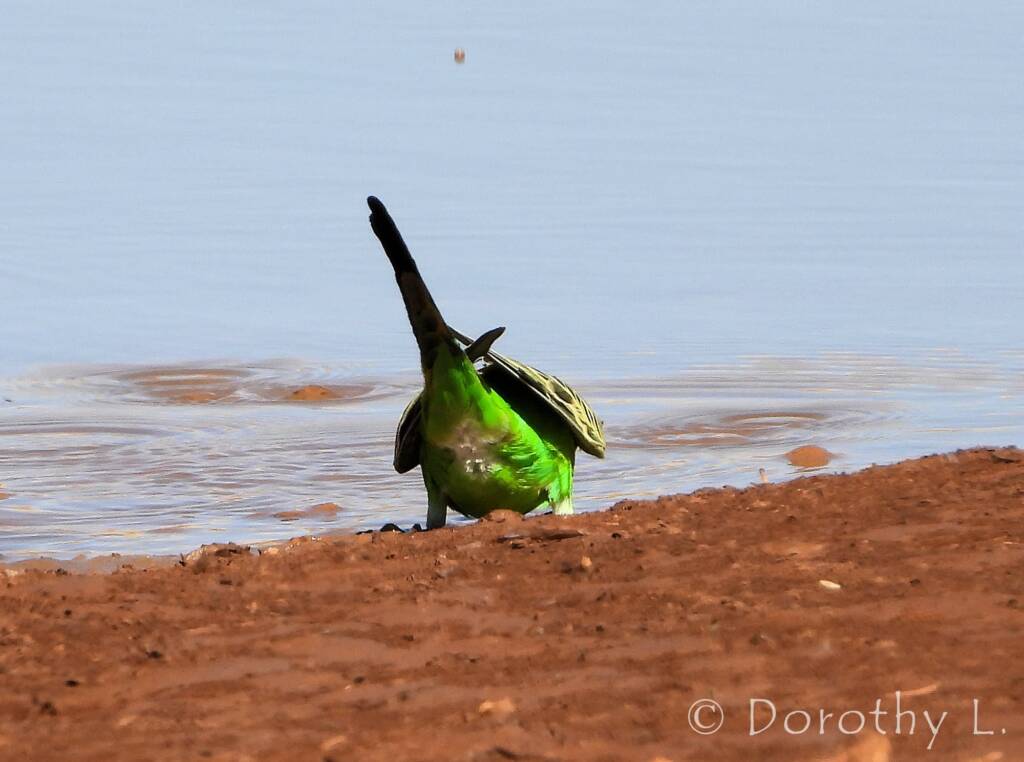BudgerigarBudgerigar – flocks & flights Budgerigar – nesting Budgerigar – juvenile Budgerigar – resting & roosting Budgerigar – water Budgerigar – mixed company Budgerigar – morphs & disabilities
One of the iconic small birds found across inland Australia is the green and yellow Budgerigar (Melopsittacus undulatus), commonly known as the budgie. Often seen in small groups, under the right climatic conditions, it is an amazing sight and sound to see them in flocks of hundreds to thousands.

Native to Australia, these small parrots are the only species in the genus Melopsittacus. They are green and yellow, have a beautiful scalloped pattern on the upperparts of their body and fine barring on the head. Their heads also have iridescent blue-violet cheek patches, with a series of three black spots on each side of the throat (called throat patches). Their tail is a beautiful dark cobalt blue, with outside tail feathers displaying central yellow flashes. They are known to have many colour mutations, including all yellow, blue and white. Some of the colour mutations could be the result of escaped captive birds that have interbred with the wild population.
The main colour of the natural wild budgies is called Light Green. In captivity where they are a popular pet, they have been bred to include other colours such as blues, whites, yellows and greys.
Following image is of the male of the species. It is the adult male budgerigar whose cere (the area containing the nostrils) that is royal blue. In the female bird it is brown to white, although it is pink in the immatures birds of both sexes. In this image you can also see the iridescent blue-violet cheek patches.

In the wild they naturally live in trees, often making nests in knots or other depressions, as well as small holes in trunks of trees, that are just large enough to hold their nests.
The Budgerigar are highly social birds in the wild, having a lifespan of up to 15 years in the wild. Those kept and bred as pets are also known to be highly social with humans.

Common name
Budgerigar, Budgie, Common Parakeet, Shell Parakeet.
Aboriginal Culture
The indigenous name for the budgie is Betcherrygah, said to be derived from the Gamilaraay Aboriginal language, betcherry meaning ‘good’, and gah meaning ‘parakeet’. Whilst good had a number of interpretation, from good to look at, good to follow to place of rainfall, water and food, or good bird to look at.
Budgerigars also feature in aboriginal dreaming, culture and art. The Dreaming story of the Warlpiri people of the Northern Territory tell of how the budgies help them locate waterholes.
They have been depicted in many artwork and sculptural installations, with one memorable artwork at the 2018 Parrtjima Festival titled:

This stunning work by artist Myra Patrick Herbert, Warnayaka Art Centre, Lajamanu, NT based on the Budgerigar Dreaming – Ngatijirri Jukurrpa. Permission was given by Myra Patrick for schools and community groups to paint abstract bird shapes to be part of the 2018 festival event.
- Scientific classification
- Kingdom: Animalia
- Phylum: Chordata
- Class: Aves
- Order: Psittaciformes
- Family: Psittaculidae
- Genus: Melopsittacus
- Species: Melopsittacus undulatus
Footnote & References
- Budgerigar, https://en.wikipedia.org/wiki/Budgerigar (last visited Apr. 8, 2021).
- Desert nomads: 4 things you didn’t know about budgies, Australian Geographic, 19 October 2018, https://www.australiangeographic.com.au/topics/wildlife/2018/10/desert-nomads-5-things-you-didnt-know-about-budgies/
- Budgerigar, BirdsSA, https://birdssa.asn.au/birddirectory/budgerigar/
- Budgerigar, mdahlem.net, https://www.mdahlem.net/birds/12/budgy.php
BudgerigarBudgerigar – flocks & flights Budgerigar – nesting Budgerigar – juvenile Budgerigar – resting & roosting Budgerigar – water Budgerigar – mixed company Budgerigar – morphs & disabilities
ParrotsAustralian Ringnecks Bluebonnet Bourke’s Parrot Budgerigar Cockatiel Galah Major Mitchell’s Cockatoo Mallee Ringneck Mulga Parrot Port Lincoln Ringneck Purple-crowned Lorikeet Rainbow Lorikeet Red-collared Lorikeet Red-tailed Black Cockatoo Sulphur-crested Cockatoo Yellow-tailed Black Cockatoo
BirdsApostlebird Australasian Darter Australasian Figbird Australasian Gannet Australasian Grebe Australasian Pipit Australasian Robins Australasian Shoveler (Spatula rhynchotis) Australasian Wrens Australian Babblers Australian Bustard Australian Chats Australian Magpie Australian Pelican Australian Pratincole (Stiltia isabella) Australian White Ibis Bassian Thrush Black-faced Cormorant Black-faced Woodswallow Black Swan Bowerbirds Brolga Brown Songlark Channel-billed Cuckoo Cinnamon Quail-thrush Cormorants Cuckooshrikes and Allies Dotterels Lapwings Plovers Doves & Pigeons Emu Fairy Martin Finches Grey Fantail Grey Teal Honeyeaters Kingfishers Little Friarbird Little Grassbird Magpie-lark Masked Woodswallow Noisy Pitta Olive Whistler Paradise Riflebird Pardalotes Parrots Pheasant Coucal Pied Butcherbird Rainbow Bee-eater Raptors Rufous Fantail Redthroat Rufous Bristlebird Silver-crowned Friarbird Torresian Crow Waders Welcome Swallow (Hirundo neoxena) Whiskered Tern (Chlidonias hybrida) White-browed Woodswallow White Capped Noddy White-faced Heron White-necked Heron Willie Wagtail Yellow-throated Scrubwren




